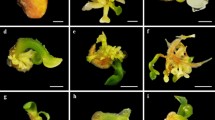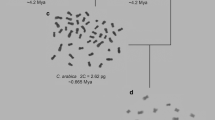Abstract
During asexual plant reproduction, cells from different organs can be reprogrammed to produce new individuals, a process that requires the coordination of cell cycle reactivation with the acquisition of other cellular morphological characteristics. However, the factors that influence the variety of asexual reproduction have not yet been determined. Here, we report on plantlet formation in Kalanchoe daigremontiana, Graptopetalum paraguayense, and Crassula portulacea (Crassulaceae) and analyse the effect of initiating cells on asexual reproduction in these three species. Additionally, the roles of WUSCHEL (WUS) and CUP-SHAPED COTYLEDON 1 (CUC1) in the asexual reproduction of these species were analysed through qRT-PCR. Our results indicated that pre-existing stem cell-like cells at the sites of asexual reproduction were responsible for the formation of plantlets. These cells were arrested in different phases of the cell cycle and showed different cell morphological characteristics and cell counts. The accumulation of auxin and cytokinin at the sites of asexual plantlet formation indicated their important functions, particularly for cell cycle reactivation. These differences may influence the pattern and complexity of asexual reproduction in these Crassulaceae species. Additionally, the dynamic expression levels of CUC1 and WUS may indicate that CUC1 functions in the formation of callus and shoot meristems; whereas, WUS was only associated with shoot induction.







Similar content being viewed by others
References
Atta R, Laurens L, Boucheron-Dubuisson E, Guivarc'h A, Carnero E, Giraudat-Pautot V, Rech P, Chriqui D (2009) Pluripotency of Arabidopsis xylem pericycle underlies shoot regeneration from root and hypocotyl explants grown in vitro. Plant J 57:626–644
Barbara B, Lieven DV (2009) Transcriptional control of the cell cycle. Curr Opin Plant Biol 12:599–605
Cary AJ, Che P, Howell SH (2002) Developmental events and shoot apical meristem gene expression patterns during shoot development in Arabidopsis thaliana. Plant J 32:867–877
Charuvi D, Kiss V, Nevo R, Shimoni E, Adam Z, Reich Z (2012) Gain and loss of photosynthetic membranes during plastid differentiation in the shoot apex of Arabidopsis. Plant Cell 24:1143–1157
Che P, Lall S, Howell SH (2007) Developmental steps in acquiring competence for shoot development in Arabidopsis tissue culture. Planta 226:1183–1194
Daimon Y, Takabe K, Tasaka M (2003) The CUP-SHAPED COTYLEDON genes promote adventitious shoot formation on calli. Plant Cell Physiol 44:113–121
Den BG, Murray JA (2000) Triggering the cell cycle in plants. Trends Cell Biol 10:245–250
Dubrovsky JG, Doerner PW, Colon-Carmona A, Rost TL (2000) Pericycle cell proliferation and lateral root initiation in Arabidopsis. Plant Physiol 124:1648–1657
Fleming A (2006a) Metabolic aspects of organogenesis in the shoot apical meristem. J Exp Bot 57:1863–1870
Fleming A (2006b) The co-ordination of cell division, differentiation and morphogenesis in the shoot apical meristem: a perspective. J Exp Bot 57:25–32
Garcês HM, Champagne CE, Townsley BT, Park S, Malhó R, Pedroso MC, Harada JJ, Sinha NR (2007) Evolution of asexual reproduction in leaves of the genus Kalanchoe. Proc Natl Acad Sci U S A 104:15578–15583
Gau RJ (2003) Plant tissue culture: the history, In: Plant Tissue Culture: 100 Years since Gottlieb Haberlandt, Springer Wien
Gordon SP, Heisler MG, Reddy GV, Ohno C, Das P, Meyerowitz EM (2007) Pattern formation during de novo assembly of the Arabidopsis shoot meristem. Development 134:3539–3548
Haywood V, Kragler F, Lucas WJ (2002) Plasmodesmata: pathways for protein and ribonucleoprotein signaling. Plant Cell 14:S303–S325
Kaoru S, Sean PG, Elliot MM (2011) Regeneration in plants and animals: dedifferentiation, transdifferentiation, or just differentiation? Trends Cell Biol 21:212–218
Kenneth DB, Alejandro SA (2008) Slicing across kingdoms: regeneration in plants and animals. Cell 132:697–710
Koroleva OA, Tomlinson M, Parinyapong P, Sakvarelidze L, Leader D, Shaw P (2004) CycD1, a putative G1 cyclin from Antirrhinum majus, accelerates the cell cycle in cultured tobacco BY-2 cells by enhancing both G1/S entry and progression through S and G2 phases. Plant Cell 16:2364–2379
Kurata T, Okada K, Wada T (2005) Intercellular movement of transcription factors. Curr Opin Plant Biol 8:600–605
Laux T (2003) The stem cell concept in plants: a matter of debate. Cell 113:281–283
Li W, Liu H, Cheng ZJ, Su YH, Han HN, Zhang Y, Zhang XS (2011) DNA methylation and histone modifications regulate de novo shoot regeneration in Arabidopsis by modulating WUSCHEL expression and auxin signaling. PLoS Genet 7(8):e1002243
Lieven DV, Jerome J, Dirk I (2003) Plant cell cycle transitions. Curr Opin Plant Biol 6:536–543
Long JA, Barton MK (1998) The development of apical embryonic pattern in Arabidopsis. Development 125:3027–3035
Lopez-Juez E, Pyke KA (2005) Plastids unleashed: their development and their integration in plant development. Int J Dev Biol 49:557–577
Marcel M, James AH (2001) Cell cycle controls and the development of plant form. Curr Opin Plant Biol 4:44–49
Mayer KF, Schoof H, Haecker A, Lenhard M, Jürgens G, Laux T (1998) Role of WUSCHEL in regulating stem cell fate in the Arabidopsis shoot meristem. Cell 95:805–815
Planchais S, Glab N, Inze D, Bergounioux C (2000) Chemical inhibitors: a tool for plant cell cycle studies. FEBS Lett 476:78–83
Quelo AH, Bryant JA, Verbelen JP (2002) Endoreduplication is not inhibited but induced by aphidicolin in cultured cells of tobacco. J Exp Bot 53:669–675
Richard GK (2006) Cytokinins inhibit epiphyllous plantlet development on leaves of Bryophyllum (Kalanchoe) marnierianum. J Exp Bot 57:4089–4098
Richard GK (2008) Hormonal control of root development on epiphyllous plantlets of Bryophyllum (Kalanchoe) marnierianum: role of auxin and ethylene. J Exp Bot 59:2361–2370
Sablowski R (2004) Plant and animal stem cells: conceptually similar, molecularly distinct? Trends Cell Biol 14:605–611
Schoof H, Lenhard M, Haecker A, Mayer KF, Jürgens G, Laux T (2000) The stem cell population of Arabidopsis shoot meristems in maintained by a regulatory loop between the CLAVATA and WUSCHEL genes. Cell 100:635–644
Schween G, Gorr G, Hohe A, Reski R (2003) Unique tissue specific cell cycle in Physcomitrella. Plant Biol 5:50–58
Singh MB, Bhalla PL (2006) Plant stem cells carve their own niche. Trends Plant Sci 11:241–246
Skoog F (1950) Chemical control of growth and organ formation in plant tissues. Annee Biol 54:545–562
Skoog F, Miller CO (1957) Chemical regulation of growth and organ formation in plant tissues cultured in vitro. Symp Soc Exp Biol 54:118–130
Slaby K, Sebanek J (1984) Content of endogenous cytokinins in intact and transversally cut leaf blades of Bryophyllum crenatum. Plant Growth Regul 2:111–116
Slaby K, Sebanek J, Psota V (1990) The release of primordial of marginal buds on Bryophyllum crenatum leaves from growth inhibition in relationship to the level of endogenous IAA. Biol Plant 32:352–356
Street HE (1977) Plant tissue and cell culture. Blackwell Scientific Publications
Su YH, Zhao XY, Liu YB, Zhang CL, O'Neill SD, Zhang XS (2009) Auxin-induced WUS expression is essential for embryonic stem cell renewal during somatic embryogenesis in Arabidopsis. Plant J 59:448–460
Sugimoto K, Jiao Y, Meyerowitz EM (2010) Arabidopsis regeneration from multiple tissues occurs via a root development pathway. Dev Cell 18:463–471
Tatyana B (2004) Polymorphism of sexual and somatic embryos as manifestation of their developmental parallelism under natural conditions and in tissue culture. Plant Biotechnology and Molecular Markers, Anamaya Publications. 43–59
Tatyana B (2005) Sexual and asexual processes in reproductive systems of flowering plants. Acta Biol Cracov Ser Bot 47:51–60
Ueki S, Citovsky V (2005) Control improves with age: intercellular transport in plant embryos and adults. Proc Natl Acad Sci U S A 102:1817–1818
Verdeil JL, Alemanno L, Niemenak N, Tranbarger TJ (2007) Pluripotent versus totipotent plant stem cells: dependence versus autonomy? Trends Plant Sci 12:245–252
Weigel D, Jurgens G (2002) Stem cells that make stems. Nature 415:751–754
Williams L, Fletcher JC (2005) Stem cell regulation in the Arabidopsis shoot apical meristem. Curr Opin Plant Biol 8:582–586
Yang Y, Feng Z, Wang G, Li F, Du X, Zhu J (2010) Initiation of dedifferentiation and structural changes in in vitro cultured petiole of Arabidopsis thaliana. Protoplasma 241:75–81
Acknowledgments
This research was supported by the National Natural Sciences Foundation of China (nos. 31370214, 31301058), the Major State Basic Research Development Program (973 Program) of China (No. 2012CB966903), and the Key Programme for Basic Research of the Science and Technology Commission of Shanghai (13JC1407102).
Conflict of interest
The authors declare that they have no conflict of interest.
Author information
Authors and Affiliations
Corresponding author
Additional information
Handling Editor: Liwen Jiang
Jiansheng Guo and Hailiang Liu contributed equally to this work
Electronic supplementary material
Below is the link to the electronic supplementary material.
Online Resource 1
(DOC 29 kb)
Online Resource 2
(DOC 33 kb)
Online Resource 3
(DOC 737 kb)
Online Resource 4
(DOC 792 kb)
Online Resource 5
(DOC 716 kb)
Online Resource 6
(DOC 504 kb)
Online Resource 7
(DOC 134 kb)
Online Resource 8
(DOC 522 kb)
Online Resource 9
(DOC 165 kb)
Online Resource 10
(DOC 368 kb)
Rights and permissions
About this article
Cite this article
Guo, J., Liu, H., He, Y. et al. Origination of asexual plantlets in three species of Crassulaceae . Protoplasma 252, 591–603 (2015). https://doi.org/10.1007/s00709-014-0704-2
Received:
Accepted:
Published:
Issue Date:
DOI: https://doi.org/10.1007/s00709-014-0704-2




